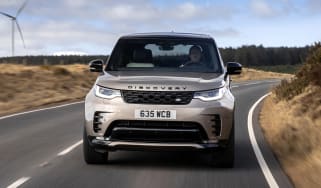Land Rover Discovery SUV (2009-2017)
“The Land Rover Discovery replacement is imminent, but the outgoing model continues to appeal thanks to its iconic styling, seven-seat practicality and off-road prowess”
Pros
- Luxurious and comfortable
- Spacious interior
- Go-anywhere ability
Cons
- Noisy at high speeds
- Expensive to run
- Feels large manoeuvring in town
Many manufacturers replace an important model roughly every seven years, but ignoring facelifts, the current Land Rover Discovery has been on sale since 2004. An all-new 2017 Land Rover Discovery is available to order, but in the meantime, the current Discovery still holds appeal.
That’s because its huge practicality means the Disco can haul up to seven people and carry or tow huge amounts of kit – and it doesn’t necessarily need a road to do it. So, while it might be wise to wait for the new Discovery, or choose an Audi Q7, Volvo XC90 or BMW X5, we can understand why you might still want the outgoing model.
While the Volvo and Audi have much more modern interiors and the BMW X5 and Porsche Cayenne offer significantly better handling, very few vehicles can match the Discovery off-road. This is in large part thanks to its clever four-wheel drive, with a system called Terrain Response that automatically adapts to the surface you’re driving over.
The Discovery doesn’t come cheap, though: the run-out version is only available with a 3.0-litre V6 diesel engine producing 253bhp, pushing fuel consumption to 36.7mpg and CO2 emissions to 203g/km. Performance is pretty good, though, the Land Rover getting from 0-62mph in under nine seconds despite weighing over two tonnes.
More reviews
With so much heft, and air suspension offering impressive travel, it’s fair to say the Discovery feels like it steamrollers the road, soaking up most bumps as if they weren’t even there. The tall body can lean somewhat in corners, but the steering is impressively sharp and accurate, which helps build confidence. Town driving might take a little while to get used to, but a high driving position, excellent visibility and the fact you look down at the bonnet helps you position the car in tight spaces.
The last examples of the Discovery are available in Graphite and Landmark trim levels, which are both quite special. They get air suspension, along with full leather upholstery and all the features (such as cruise control) that you’d expect from a luxury SUV, as well as a Meridian stereo. Being the top-spec version, Landmark gets more sumptuous leather, six additional speakers, navigation and a sunroof – but Land Rover asks an £8,500 premium for this.
While the cabin looks years behind the Volvo XC90 with its portrait touchscreen display, the Discovery hasn’t aged too badly. That’s probably because its simple layout and materials like wood and leather still look good – and luxurious. There’s room for five adults in the front two rows and two adults can even fit in the third row as long as it’s not for too long.
Luggage capacity of 280 litres even with all seven seats in use is better than many MPVs manage, as is the huge 1,124-litre boot behind the rear seats. While it might not seem like a deal-breaker, some might choose to stick with the outgoing Discovery because of its split rear tailgate, which the new model ditches in favour of a simple hatchback. The section that folds flat is certainly ideal for picnics, or sitting on to take off your muddy boots after a hike.
Customers certainly seem happy with the Land Rover Discovery, placing it 26th out of 150 models in our 2016 Driver Power customer satisfaction survey, which is all the more impressive given its imminent retirement. Coming second for practicality is an indication of just how versatile the Discovery is, but a 108th-place finish for reliability could be a concern.
Safety isn’t necessarily the Discovery’s strong point, because the last version to be crash-tested by Euro NCAP was the Discovery 3 in 2006. It scored four out of five stars and the test has been made much stricter in the past few years. But the Discovery has evolved, too, with bodywork changes and new safety kit like blind-spot monitoring.












